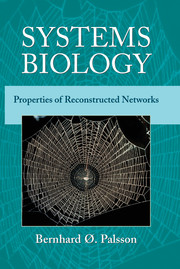Book contents
- Frontmatter
- Contents
- Preface
- 1 Introduction
- 2 Basic Concepts in Systems Biology
- PART I RECONSTRUCTION OF BIOCHEMICAL NETWORKS
- PART II MATHEMATICAL REPRESENTATION OF RECONSTRUCTED NETWORKS
- PART III CAPABILITIES OF RECONSTRUCTED NETWORKS
- APPENDIX A Nomenclature and Abbreviations
- APPENDIX B E. coli Core Metabolic Network
- Bibliography
- Index
2 - Basic Concepts in Systems Biology
Published online by Cambridge University Press: 05 September 2012
- Frontmatter
- Contents
- Preface
- 1 Introduction
- 2 Basic Concepts in Systems Biology
- PART I RECONSTRUCTION OF BIOCHEMICAL NETWORKS
- PART II MATHEMATICAL REPRESENTATION OF RECONSTRUCTED NETWORKS
- PART III CAPABILITIES OF RECONSTRUCTED NETWORKS
- APPENDIX A Nomenclature and Abbreviations
- APPENDIX B E. coli Core Metabolic Network
- Bibliography
- Index
Summary
In the early 1960s, there was a bifurcation of emphasis in biology. Molecular biology had arrived, providing a growing understanding of DNA, protein, and other chemical components of cells. A science was emerging that had rigor in terms of analytical chemistry and controlled experimentation, and relevance to biochemical and genetic functions of cells and occasionally to their phenotypes. Holistic emphasis in biology, which had primarily been practiced through physiology, faded into the background as it is much more difficult to state hypotheses, do controlled experiments, or execute the scientific process for the behavior of systems and networks in biology. However, as outlined in the introductory chapter, this situation has now changed. We now have technology that allows for the detailed enumeration of biological components, enabling us to study cells and complex biological processes as systems. As a consequence, systems biology has arisen as a new field. This new field does not yet have a well-defined and articulated conceptual basis. In this chapter, we will attempt to collect some of the key issues that represent to the conceptual foundations of systems biology. Its content is not intended to be, and cannot be, complete but rather represents an attempt to initiate this process.
Components vs. Systems
Biological components all have a finite turnover time. Most metabolites turn over within a minute in a cell, mRNA molecules typically have 2-hour halflives in human cells, 3% of the extracellular matrix in cardiac muscle is turned over daily, and so forth.
- Type
- Chapter
- Information
- Systems BiologyProperties of Reconstructed Networks, pp. 12 - 26Publisher: Cambridge University PressPrint publication year: 2006



